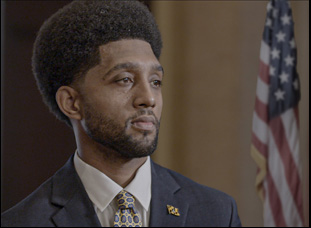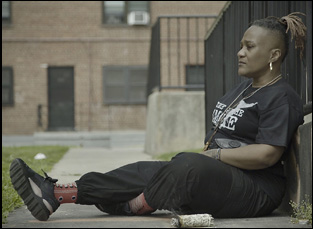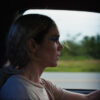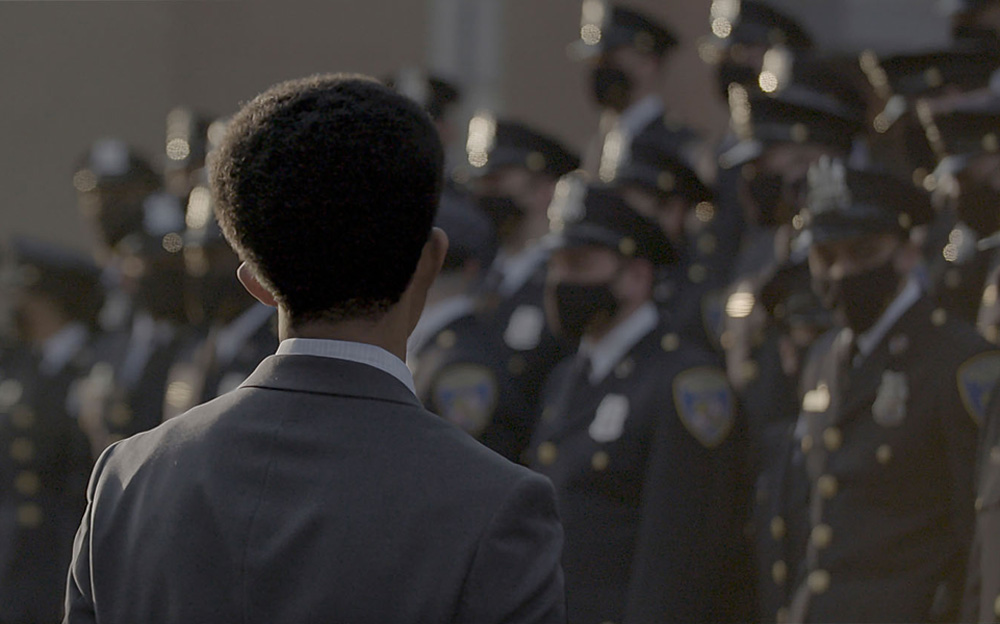“The Body Politic” opens with an unexpected sight as Erricka Bridgeford arrives to a murder scene in Baltimore, offering hugs to anyone who needs them and burning incense to cleanse the space. It’s what she would’ve wanted during one of the scariest moments of her life when she lost a loved one to gun violence a few years earlier and since tragedy struck, she devoted her life to being an anti-violence advocate in the community, having her perspective changed by the experience as much as it has changed hers.
“It just occurred to me, [or rather] all the angels, ancestors, spirit guides said to me, the places where people are murdered should be sacred ground,” Bridgeford said recently of the ritual she’s practiced every time she’s visited a crime scene. “The concrete cries out, the grass cries out, the streets cry out that a human being showed up with that hatred and confusion or whatever it was that made them believe murder was the choice they had to make, and just like humans did that, humans could show up and reclaim it and bless the space so that that would not be the last memory for that neighborhood in that space, and people who didn’t even know you showed up to honor that you still exist in the universe and to seal that space with love and light. It really was from my own family’s pain that made me realize there was an opportunity for life.”
It’s a way of seeing things differently that makes Gabriel Francis Paz Goodenough’s look at his hometown in a moment of crisis as hopeful as it is inevitably tragic when Baltimore’s murder rate is unusually high, charting nearly one a day in 2019 with no obvious end in sight. Bringing the numbers down seem like a tall task for anyone to take on, but it’s part of why city councilman Brandon Scott ran for mayor in 2020, which may have seemed as improbable when he was just 36 years old and pulled ahead of far more established candidates only when the energy of protests in the wake of George Floyd’s death carried over into the election. Goodenough may have only planned to follow Scott’s longshot campaign and then after his surprise victory, his first year in office, but what the director ended up capturing is far more sprawling as Scott looks to connect a number of different factions in the city to implement a group violence reduction strategy, requiring a coalition of community organizers, police and the State’s Attorney’s to work together to watch over the streets and end a vicious cycle by lowering recidivism.
Although Goodenough shows Baltimore at a standstill, it isn’t to say no one is taking action as then-Maryland Governor Larry Hogan would say, refusing to meet with Scott while the mayor is actively trying to unlock various levers of power from the bureaucracy above him to put his plans into practice after local officials have assiduously worked together towards solutions. The film reveals the political machinations involved, for better or worse, when Scott and others build consensus about a way forward while more image-conscious politicians show their true colors behind closed doors, slowing down any potential for reform when they can use the city as a punching bag to push their own agenda. Still, by training its lens on not only Scott but others like Bridgeford who become increasingly aware of the power they have by speaking out, “The Body Politic” proves inspiring and reflects a community that won’t be defeated. With the film now in theaters for its Oscar-qualifying run before airing on POV on PBS in November, Goodenough and Bridgeford spoke about showing this side of a city they love so much that hasn’t been presented as much on screen, the effects of another pandemic besides violence on the film when shooting in 2020 and how the film reaches beyond Baltimore to tackle issues any metropolis is bound to face in making decisions about the future.

Gabriel Francis Paz Goodenough: Well, it’s been about five years now. I’d worked in film for about 30 years, starting as a P.A., became a camera assistant, then did a bunch of operating on a lot of documentary stuff. Then I got sick. I was diagnosed with cancer in my right leg, so I lost part of the bottom of my right hip and a bunch of muscles in my right leg. That put a damper in my ability to do handheld camera work, so I wanted to do a film about my hometown, the place that I love more than any other on the planet. I wrote a grant [application], even when I was still in the hospital. That was the gateway drug to this whole experience, a little bit less than five years ago and we got the first grant and it’s been this huge odyssey.
We thought we were making an election film, like Baltimore’s version of “Street Fight.” The whole world changed. George Floyd was murdered and we quickly came to the realization that we needed to follow whoever won into office and that was Brandon. Then we had the honor of following him for a year in office and we had all this footage and had to figure out what to do. What you viewed is the, the amalgamation of like 732 hours of footage.
It seems wild now that you spent the first year covering the election and then the first year of governance, largely staying close to the mayor due to COVID and then go to the outside when he’s able to get out more into the community as well. Was that an interesting part of this?
Gabriel Francis Paz Goodenough: Yeah, when Brandon first entered office, COVID was in full outbreak, so it really wasn’t the most dynamic thing to film. There was a lot of Zooming happening and a lot of phone calls and that’s why you end up seeing us go out with allies and lieutenants of Brandon with Erricka and with Dante because we wanted to be able to show the tangible work that is happening. A lot of what it is to be a mayor truly is not really all that exciting. It’s a lot of legislation and paperwork and phone calls and obviously we condensed it into 90 minutes, and COVID was the big challenge through the whole thing, but really it was [the question of] how do we attach what’s happening in the real day-to-day in the community of Baltimore with what’s also happening with Brandon. You have this young guy that is trying to do long-term change, but while he’s doing long-term change, he has to deal with the pressure of all the short-term trauma that’s happening and he’s got to remain steadfast to that long-term goal, so that hopefully generations from now, or even five years from now, children won’t have to live with the same things they’re living with right now in Baltimore.

Erricka Bridgeford: I met Gabriel — the scene in the film after Tater [Barksdale, an activist for Safe Streets] was murdered, there was a celebration of his life where I spoke. It was not long after his birthday, and there were news cameras all around there, so Gabe was just one of the cameras at the time. But afterwards he came up to me and said that he was making a film about Baltimore’s healing and he wanted to meet with me to talk about being involved in it. You say Baltimore and healing together and you got me right there, and it meant a lot to me too that he said he was filming Tater’s celebration of life like his birthday party, so that was already a good sign to me. We met and he explained to me what it was he was doing and I’m really excited that I could be a part of it.
One of the really moving moments in the film is when Erricka is talking about how you couldn’t have done some of what you’re doing now as far as speaking to people and helping others to process their trauma by being strong for them in that way. What’s it like to reflect on how far you’ve come when you’re leading a project like this?
Erricka Bridgeford: Yeah, some of it is definitely learning as I go. Years ago, I was involved in helping to repeal Maryland’s death penalty and I had a mentor named Bonita Sykes, who was very involved in that movement. She taught me a lot about how to talk to media and you should always be answering the question that you want answered, not necessarily the question that they’re asking you. I learned that pretty early, and also that you get interviewed for however long, but then there’s just a six-second snippet of what you would [say is] actually shown on the news. So I learned to say things that no matter how they cut it up, it always sounds like I said something good. But I did not know [early on] that I could actually ask them questions.
What taught me that is just doing the work, realizing how misunderstood Baltimore was, even by Baltimoreans, and how we focus on murder and violence in a way that glorified it over peace and glorified the fact that we were losing people [rather than] recognizing how much work was being done for Baltimore’s healing. The question was always what’s wrong with Baltimore instead of what happened to people in Baltimore. That’s a conversation I learned to have with people a lot and it started irritating me when media [would] ask questions that assumed there was something wrong with Baltimore. No matter how hard we’re working, [they would ask] how come it’s not working? And just doing the work taught me that of course it’s work.
One of my favorite things, Dante, who’s in the film, said at a panel discussion, was “Those of us who are doing work, we realize it’s changing all the time. We don’t have to wait until the end of the year when they give us the numbers of how many people got killed or didn’t get killed, we’re doing the work every day. We see how many lives were blessed and how many lives were changed and that’s a number nobody gives us at the end of every year.” So it’s experience gives you wisdom and I’ve been doing this work for almost 30 years now. There’s some things I had to learn through trial and error, some things I came in naturally with just because of who I am, but doing the work brings a lot of wisdom.
Gabriel, was there anything that changed your ideas of what this could be?
Gabriel Francis Paz Goodenough: The murder of George Floyd changed everything — it changed world consciousness. but it’s just like you see it in the film. When that election day ended, Brandon was down by 3,000 votes and it was getting all of those first-time voters and those new voters out, after counting votes for seven days, he came basically from a 6,000 vote deficit [to take a 3,000 vote lead]. It was clear [what happened because] everybody had been sheltering in place because of COVID, but it seemed like the world and the country just woke up at that moment and we really wanted to see how stuff worked from the inside, so that was the biggest change. Then there was a huge challenge in the edit with having 700-plus hours of footage, and how do you put everything together. There’s tons of really important and amazing stuff that happened during the election that’s not in the film, and that was a traumatic experience for me. It took months and months to slowly whittle down what we were going to put in there.
Erricka Bridgeford: There are things that Gabe filmed that did not make it in there that I was looking forward to seeing. He came to my house and filmed me putting on my wings and putting on my African dots on my face and we did a beautiful shoot in Druid Hill Park that didn’t make it into the film. We went into the studio with a Baltimore poet, and she made a poem that would’ve been, and that didn’t really make it. But I still love that people get to look at Baltimore through the eyes of somebody who loves our city. The way the film is shot is beautiful, and it makes people check their judgments about Baltimore and cities like Baltimore and people who live there. It makes people realize how much they’ve been judging and asking the wrong questions about what’s going on with people and what change really looks like and how we really do love ourselves. Baltimore really is a city of people who do everything they can to try to heal and help and we get people around the world get to say, “Oh my goodness, Baltimore is not just ‘The Wire.’ Baltimore is actually this place filled with so much love and so much life and so much healing. That’s my favorite thing about the message that people are left with.
What’s it been like getting to share this with the world?
Gabriel Francis Paz Goodenough: What has been amazing is that the film has been embraced throughout the world — in Nebraska and Alaska and the Hague — and we’ve realized that there’s so much commonality and similarity in humanity. Violence is a human disease. It’s one that we’ve been very afflicted with here in the United States, specifically gun violence, but there’s so many similarities in places that we thought were as different as they could be from Baltimore as possible. It’s also great to just have human interaction. You spend so much time in front of a screen, and it’s great to show something and get human feedback. That’s why we all do this.
Erricka Bridgeford: That’s one of my favorite things too. We were able to meet people who are doing violence interruption work and addressing public health issues and all kinds of social justice issues wherever they live, so people just felt really seen. But also people got inspired and reminded that anything that their heart is calling them forth to do, they might as well just go on and try to do it, right? Because they see this film is filled with people just following our hearts, no matter what it looks like outside of us. Everybody has that in them, something that they care about in the world, that their heart is going, “Come on, come on. You want to do this little or big thing,” and we talk ourselves out of it so much. We go, “Well, who am I to be doing this?” This film really does go, why don’t you? Who are you to not do this thing? Look what happens if you just try a little bit. The way that it reminds people of that their own hearts matter, I also love that.
“The Body Politic” opens in Los Angeles on October 18th at the Laemmle NoHo.




